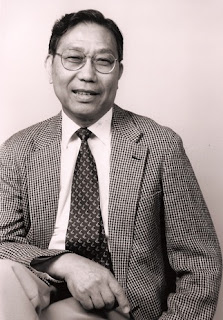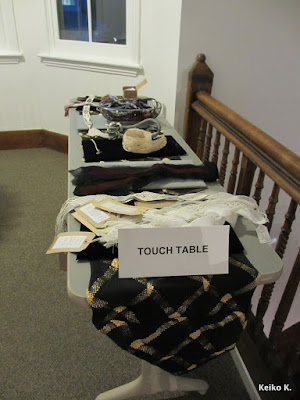6/16/16 Update: Robert Maeda's memorial service will be held on Saturday, June 25, 2016 at 3pm at Brandeis University in Rapaporte Treasure Hall in the Goldfarb Library, 415 South Street, Waltham, MA 02453. The service is open to the public.
I learned a couple of weeks ago that one of our local Japanese American community leaders passed away last month. Robert J. Maeda was Professor Emeritus of Fine Arts at Brandeis University where he taught for 33 years before retiring in 2000. He was the first Asian American hired by Brandeis to teach Asian Art. The Brandeis Fine Arts Department described him as "an inspiring teacher for generations of Brandeis students, a cherished colleague and friend, and a warm, re-assuring presence to all who knew him." Robert was also former president and long-time member of the board of the New England Chapter of the Japanese American Citizens League.
I never met Robert, but I did meet his daughter, theatre artist Kimi Maeda, when she performed a very moving play about her father's life and his struggle with dementia at Brandeis last year. Kimi is about to start a Northeastern tour of that show and will be performing Bend in Boston from Friday, February 19th to Saturday, February 27th. I encourage people to attend and support Kimi in her journey to keep her father's memory alive. The following essay was published in the New England JACL's mid-February newsletter.
A special message from Kimi Maeda
Robert Maeda’s daughter, Kimi, is undertaking a Northeastern tour of Bend, her one-woman stage production created to honor her father’s experiences during World War II. She sent us this message.
For the past few years my father has been slowly fading away. The illness that began as a wrong turn on a familiar drive home eventually reduced him to the shallow breathing that kept us on edge by his bedside. When he died, he left an emptiness in his wake.
People ask me if it is difficult to be doing a performance about his life so soon after his death. In some ways I think it is actually comforting. I created this show during his illness as a way to cope with everything that I was feeling. Rehearsing in preparation for the tour has been similarly therapeutic. I come into the studio every day and draw my dad over and over again while I listen to recordings of his voice. I am memorizing the shape of his face and the wrinkles on his brow. He feels very present, and that is filling the emptiness.
Bend is about forgetting, but it is also about memory. The New England Chapter of the JACL and I originally intended this Day of Remembrance Tour to commemorate Roosevelt signing Executive Order 9066 which led to the incarceration of Japanese American families on the West Coast after the bombing of Pearl Harbor. Now I think it is actually a fitting memorial for my father, as well.
A friend of mine whose father died recently wrote that “After the initial flurry of burial, obituary, and funeral arrangements passed, I began to think more about my dad from when he was healthy. The years of sickness have faded more, and the memories of my dad through all the years of my childhood and beyond have become stronger. It was like when my dad passed, the years of illness did too, and I was left with the times of what really mattered.” In Bend I express my fear that my father’s memory will be forgotten. However, this tour is not only allowing me to keep his memory present, it is also giving me the opportunity to share his story with so many people.
The following tribute to Robert was included in the New England JACL's mid-February newsletter.
New England JACL has lost a wonderful friend, Robert Maeda. Robert passed away on Saturday, January 30, at the age of 83. He served as our JACL president in the 1980s and was active in the Japanese American community’s successful efforts to fight for reparations for families incarcerated in American’s concentration camps during World War II. He was a long-time member of our chapter’s Board and was always available to us as a speaker on any subject we required, especially on the arts. Robert was a professor of Asian Art at Brandeis University until his retirement in 2000. During his career he was a prolific scholar and his research centered around paintings from the Sung Dynasty as well as the Japanese American artist, Isamu Noguchi. Robert is survived by his wife Nobuko of Concord, MA; his daughter Kimi of Columbia, SC; and his sister Edith of Skokie, IL. A memorial service will be held later this year. For the Concord Journal obituary, go to: [Legacy.com].
Robert's official obituary, which was published in The Concord Journal, can also be seen at Legacy.com.
Robert J. Maeda passed away on Saturday, January 30 at age 83. Robert was the Robert B. and Beatrice C. Mayer Professor of Fine Arts, Emeritus at Brandeis University and was a longtime resident of Concord, MA. He is survived by his wife Nobuko, of Concord, MA, his daughter Kimi, of Columbia, SC and his sister, Edith, of Skokie, IL.
Robert was born in El Centro, CA in 1932, the seventh child of Junichi and Tetsue Maeda. In 1942, the family was sent to the Colorado River Relocation Center in Poston, AZ as one of the thousands of Japanese American families forced into incarceration during WWII. From Poston, Robert moved with his family to Chicago, IL, where he eventually graduated from Lane Tech High School in 1950. He received a B.A. in Western Art History from the University of Illinois in 1953. Beginning in 1954, he served a total of eight years in the US Army and Army Reserves achieving the rank of Specialist, 4th Class. In 1960, he received an M.A. in Asian Art History from the University of Michigan and in 1969 completed his PhD at Harvard University in Asian Art History.
In 1967, Robert was hired as the first Asian American professor to teach Asian Art at Brandeis University. He spent his entire teaching career at Brandeis, retiring in 2000. Throughout his career, Robert was the recipient of many fellowships and awards, including a Fulbright fellowship in 1964 that took him to Japan. In 1973 Robert was a member of the Chinese Archaeology Delegation, the first group of art historians from the US to visit China. A prolific scholar, Robert’s research centered around paintings from the Sung Dynasty as well as the Japanese American artist Isamu Noguchi. Among his best known works are Two Sung Texts on Chinese Painting and the Landscape Styles of the 11th and 12th Centuries, published by Garland Press and “The ‘Water” Theme in Chinese Painting,” published in Artibus Asiae, in 1971.
In addition to his scholarly work, Robert was a leader in the Japanese American community in Massachusetts, serving on the board of the New England Chapter of the Japanese American Citizens League (JACL) and the Nisei Student Relocation Commemorative Fund. As president of the board of the regional JACL in the 1980s, Robert was active in the organization’s successful fight for reparations for families incarcerated in relocation centers during WWII.
Following his retirement, Robert continued to serve his community by teaching art history classes at Concord Village University and volunteering at Emerson Hospital in Concord.
A memorial service for Robert will be held later this year. In lieu of flowers, the family asks that donations be made in Robert’s honor to the Japanese American Citizens League, New England Chapter, P.O. Box 592, Lincoln, MA 01773 or Brandeis University, www.brandeis.edu.
The above are reprinted with permission of the New England JACL and Kimi Maeda. Messages for the family can be left at the Dee Funeral Home website.














